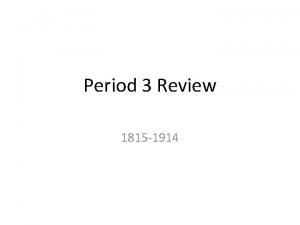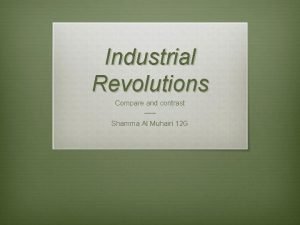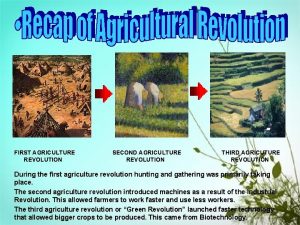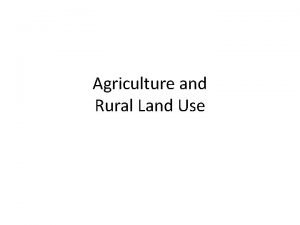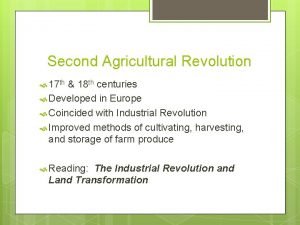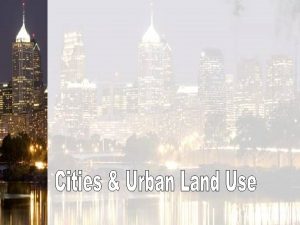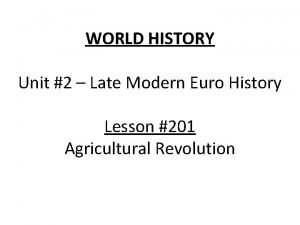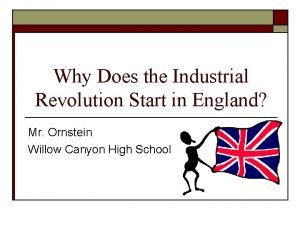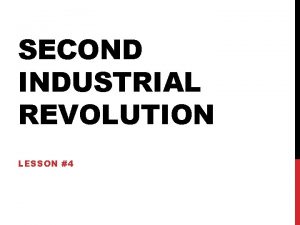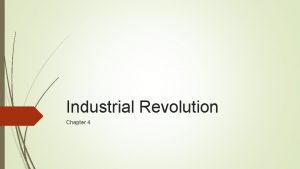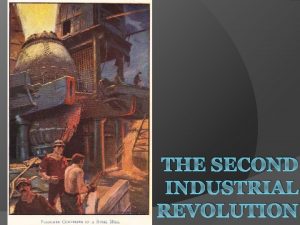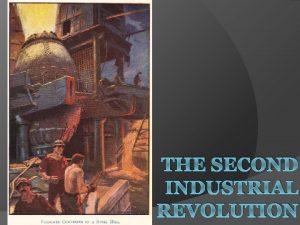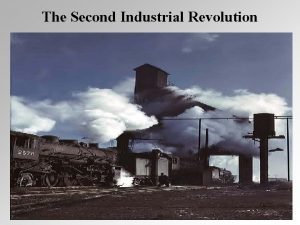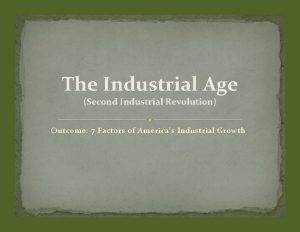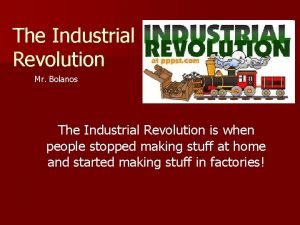THE INDUSTRIAL REVOLUTION Part II The Second Industrial













- Slides: 13

THE INDUSTRIAL REVOLUTION Part II

The Second Industrial Revolution • The First Industrial Revolution gave rise to textiles, railroads, iron, and coal. • The Second Industrial Revolution will result in steel, chemicals, electricity, and petroleum

STEEL • Steel was stronger than iron. Once a process was developed to produce it cheaply…lighter, smaller, and faster machines and engines could be produced as well as railways, ships and weapons.

ELECTRICITY • Electricity could be used for light, heat and motion. • The first practical generators of electricity were developed in the 1870’s. • Electricity gave birth to a series of new inventions: – Light bulb by Thomas Edison – Telephone by Alexander Graham Bell – Radio waves by Guglielmo Marconi

ELECTRICITY • Electricity powered street cars and subways • Electricity transformed the factory. – Conveyor belts, cranes and machines can all be powered by electricity – Electric lights meant that factories could be open 24 hours a day

INTERNAL COMBUSTION ENGINE • Provides a new source of power and transportation – Ocean liners – Automobiles • Gottlieb Daimler and Wilhelm Maybach produce the first gas powered car in 1889 • Henry Ford revolutionized the car industry in 1908 using an assembly line to mass-produce the Model T – Airplanes • Orville and Wilbur Wright make the first fixed wing flight in December 17, 1903 at Kitty Hawk, North Carolina • 1919 the first passenger air service was established • Creates a need for oil production

New Patterns • Industrial production grew at a rapid pace after 1870 because people are buying manufactured goods. • Sales increased for two reasons: – Wages increased – Production costs decreased especially transportation • Department stores

New Patterns • Western Europe became industrialized nations with a high standard of living and decent systems of transportation – Great Britain, Belgium, France, Netherlands, Germany, western part of the Austro-Hungarian Empire, and Northern Italy • Southern and Eastern Europe remained mostly agricultural with little industry – Southern Italy, Austria-Hungary, Spain, Portugal, the Balkan kingdoms, and Russia

THE COMMUNIST MANIFESTO • Written by Karl Marx and Friedrich Engels because of the horrible conditions found in factories and cities. • Industrial capitalism was blamed for these conditions

THE THEORY • All history is based on class struggle – the “oppressors” vs. the “oppressed” • The oppressors own the means of production (land, raw materials, money, etc. ) and have the power to control governments and society (ruling class) • The oppressed depend on this class for survival

THE THEORY • In Marx’s day it was the Bourgeoisie (industrial middle class) who were the oppressors and the Proletariat (working class) were the oppressed. • Marx predicted that this struggle would eventually lead to a violent revolution and the proletariat would overthrow the bourgeoisie and form a classless society where everyone worked for the good of all.

SOCIALIST PARTIES • Various socialist parties form based on the ideas of Marx • Some socialist parties promote violent revolution and the overthrow of capitalism worldwide. • Other socialist parties rejected the revolutionary approach and sought reforms by working through the democratic process.

TRADE UNIONS • Trade unions developed to help the working class meet their demands by having power in numbers. • The strike (work stoppage) was used to pressure an employer to meet worker’s demands • Better working and living conditions resulted.
 The second industrial revolution timeline
The second industrial revolution timeline First and second industrial revolutions
First and second industrial revolutions 186 282 miles per second into meters per second
186 282 miles per second into meters per second Agricultural revolution
Agricultural revolution Whittlesey agricultural regions
Whittlesey agricultural regions Redlining ap human geography
Redlining ap human geography The second agricultural revolution coincided with
The second agricultural revolution coincided with Urban hearth menu
Urban hearth menu Russian revolution vs french revolution
Russian revolution vs french revolution Could the french revolution have been avoided
Could the french revolution have been avoided Definition of third agricultural revolution
Definition of third agricultural revolution Quan hi
Quan hi Enclosure movement
Enclosure movement Why did the industrial revolution start in britain
Why did the industrial revolution start in britain
